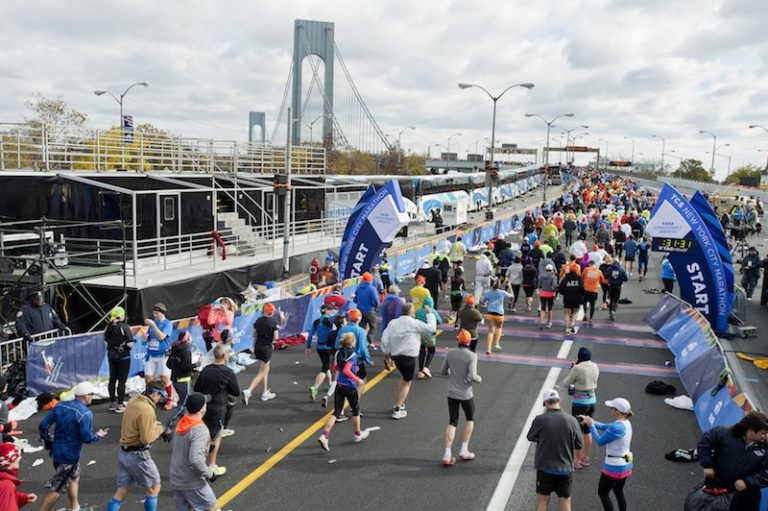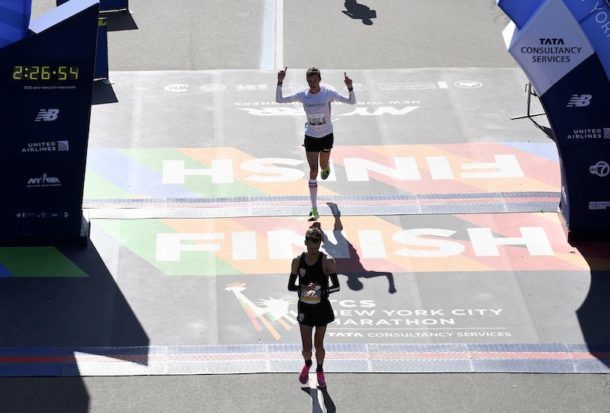
Experience the American dream by participating in the New York Marathon! Explore one of the world’s most renowned marathons, celebrated for its magical atmosphere. Annually, 50,000 runners embark on this journey, a remarkable evolution from its inaugural event in 1970, which started with just 127 participants.
Get your comprehensive guide to the New York Marathon, courtesy of Guillaume Adam, the leading French runner in the 2019 and 2023 New York City Marathons.
Contents
The evolution of the New York Marathon: from Central Park origins to a five-borough spectacle
Central Park beginnings
The inaugural New York Marathon, dating back to 1970, was confined to the loops of Central Park. Remarkably, in those early days, the entry fee was a mere one dollar for the full 26.2 miles.
Expansion to the five Boroughs
In a transformative move in 1976, co-founder Fred Lebow reimagined the marathon’s route to span all five boroughs of New York: Staten Island, Brooklyn, Queens, The Bronx, and Manhattan. This change brought a surge in participation, with 1,549 runners, comprising 1,486 men and 63 women.
Today, the New York Marathon retains its iconic course through the city’s five districts, starting in Staten Island, mere meters from the Verrazzano-Narrows Bridge. The start of the race is a majestic event. The American national anthem plays, NYPD helicopters soar overhead, and a cannon fires, all set to the stirring tune of Frank Sinatra’s ‘New York, New York’. This opening sets the stage for a race that’s not just a sporting event, but a celebration of the spirit of New York.

Memorable Editions of the New York Marathon
2001: Resilience in the wake of tragedy
In 2001, just two months following the September 11 attacks, the Mayor of New York made the significant decision to proceed with the marathon as planned. This decision was emblematic of the city’s determination, tenacity, and resilience in the face of adversity. The marathon that year was marked by an overwhelming sense of emotion and solidarity. It reflected the indomitable spirit of New Yorkers during a time of national mourning.
2012: The impact of hurricane sandy
In 2012, New York faced another formidable challenge when Hurricane Sandy struck, leaving parts of the city devastated. The storm resulted in the tragic loss of forty lives. Hundreds of thousands were left without essential utilities like electricity, heating, and water. Despite initial discussions about proceeding with the marathon, given the thousands of runners who had already arrived in the city, the organizers ultimately made the difficult decision to cancel the 43rd edition of the New York Marathon.
New York City Marathon registration: A comprehensive guide
Registering for the New York Marathon can be as challenging as the race itself. Indeed, it requires meticulous planning, often months or even years in advance, especially if you’re entering through the lottery system.
Lottery registration process
- The lottery registration for the New York Marathon typically opens on the official New York Road Runners (NYRR) website from mid-January to mid-February.
- Applicants from all over the world can enter this lottery during this period.
Qualifying with a reference time
- For guaranteed entry, runners need to have achieved a specific qualifying time. The reference time for guaranteed entry is 2 hours and 53 minutes for men or 3 hours and 13 minutes for women under 35 years old, in either a marathon or a half-marathon.
- Those who have not achieved these times or who have completed fewer than 15 New York City marathons will need to enter the lottery.
The lottery system
- The odds of being selected through the lottery for non-Americans average about 1 in 10.
- Group registration in the lottery is also an option, convenient for those planning to participate with friends or family.
Travel agency route
- An alternative to direct registration is going through an approved travel agency.
- This option is particularly suitable for those marking special occasions, such as birthdays, and typically includes the marathon bib, plane ticket, and accommodation.
New York Marathon course: A unique challenge amidst iconic scenes
The Course of the New York Marathon
The New York Marathon kicks off in Staten Island, with a starting dash over the Verrazzano Bridge.
Runners then weave through Brooklyn and Queens, absorbing the local vibrancy. A pivotal moment is the crossing of the Queensboro Bridge into Manhattan, an unforgettable experience amidst towering skyscrapers.
The route briefly veers into the Bronx, then down Fifth Avenue, culminating in the famed Central Park finish line. Each borough adds its own flavor to this challenging yet exhilarating course.
The course in a map

The course in a video
Romain Adam, co-founder of RunMotion Coach, offers a captivating video tour of the 2023 New York Marathon, providing insights into navigating this challenging yet exhilarating course.
Strategies for tackling the New York City Marathon course
While the marathon’s bridges add to its difficulty, deterring personal bests, the race is more about the atmosphere and the unique opportunity to experience New York City. To enhance your marathon experience, here are tips from Guillaume and Romain Adam, the RunMotion Coach co-founders. Guillaume was the top French finisher in 2019 with a time of 2h26, placing in the top 50 overall, and in 2023, he impressively finished 34th overall.
Potential challenges on the course
- The Verrazzano Bridge: The initial uphill can be deceptive. It’s crucial to start conservatively and maintain a relaxed pace on the subsequent downhill.
- The Vibrant Brooklyn Atmosphere: It’s easy to get carried away by the crowd’s energy. Stick to your pre-planned pace to avoid burning out early.
- The Queensboro Bridge: Known as the marathon’s most daunting bridge, it features an 800-meter uphill stretch. Slowing down by 15-20 seconds here can help conserve energy for the latter half of the race.
- Bridge to the Bronx: Encountered around the 32-kilometer mark, this bridge is less challenging but still requires careful pacing to avoid the dreaded marathon “wall.”
Practical information for running the New York City Marathon
When planning your trip to the United States for the New York Marathon, especially from Europe, managing the time difference and transportation to the start line are key factors to consider for a smooth experience.
Managing the time difference
- Arrival time: It’s advisable to arrive 2-3 days before the race, ideally by Thursday. This allows for minimal sightseeing before the marathon, conserving energy. Post-marathon days can be reserved for exploring the city.
- Jet Lag advantage: Traveling westward often results in waking up early naturally, which can be beneficial on the morning of the marathon. You’ll likely find yourself awake early, providing ample time for breakfast and preparations.
Transport to the starting line
- Shuttle services: The marathon’s official shuttle services start as early as 5 AM, with departures generally before 6 AM from Manhattan. Using these shuttles is crucial as the Verrazzano Bridge, the marathon’s starting point, closes a few hours before the event.
- Taxi option: Taxis are an alternative, but they must be booked for an extremely early departure due to bridge closures.
- No personal belongings at start: It’s important to remember that you cannot leave personal items at the starting area. If you need to stay warm before the start, consider bringing old clothes that you can discard in the provided bins.
Budgeting for the New York City Marathon: An overview
Participating in the New York Marathon can be a significant investment, especially for non-Americans. Here’s a breakdown of the approximate costs involved:
- Marathon Bib Price
- For non-Americans: $358
- For U.S. residents: $295
- Flight Costs
- From Paris or other European cities to New York: Ranges between $300 (with advance booking) and $1000.
- Accommodation
- Hotel or Airbnb prices per night: Between $200 and $800.
- Note: Accommodation in New York can be quite pricey.
- Meals
- Expect to spend a minimum of $30 per person, considering menu prices plus 15 to 20% tips.
With a frugal approach, the budget could be around $1500, but expenses can escalate to $2500-$3000, particularly when using a travel agency. The advantage of a travel agency is the convenience of having everything organized, leaving you to focus solely on the race.
Additional considerations
- RunMotion Coach Premium Subscription: For $119.99 per year, you can enhance your preparation with a personalized marathon training plan and exercises for leg muscle strengthening, specifically tailored for tackling the New York Marathon’s bridges.
If you’re looking to prepare for this extraordinary event or qualify directly for this marathon, the digital coach RunMotion Coach is there for you!